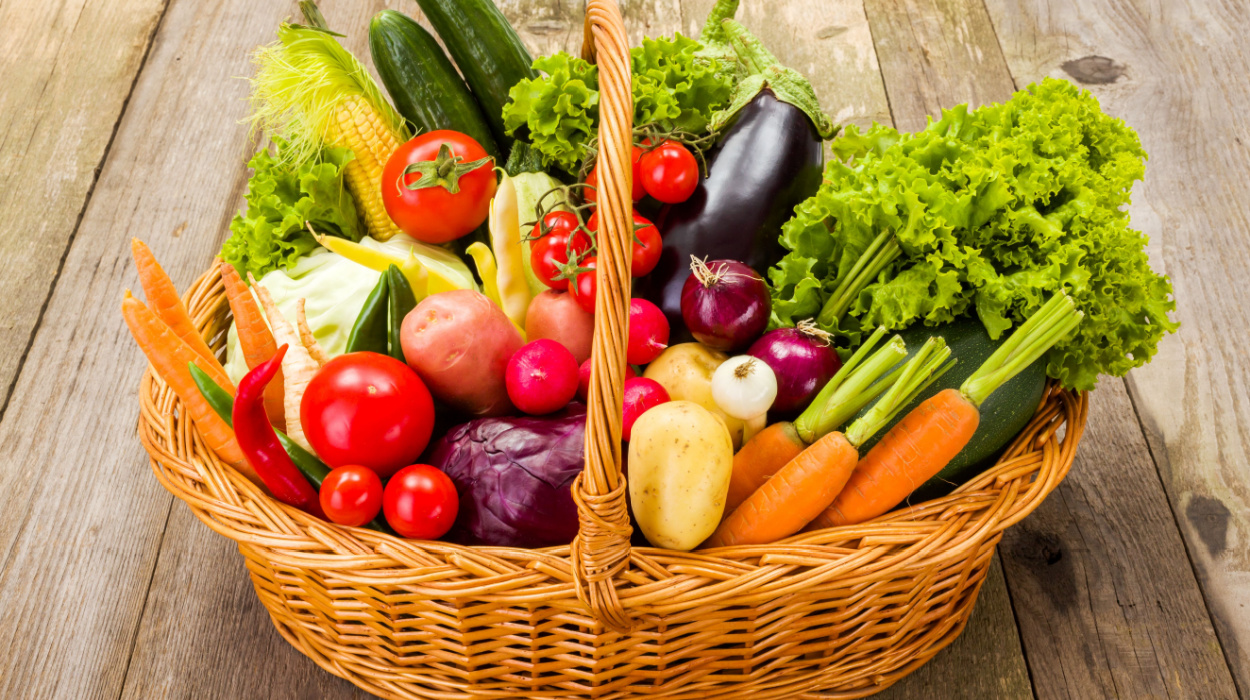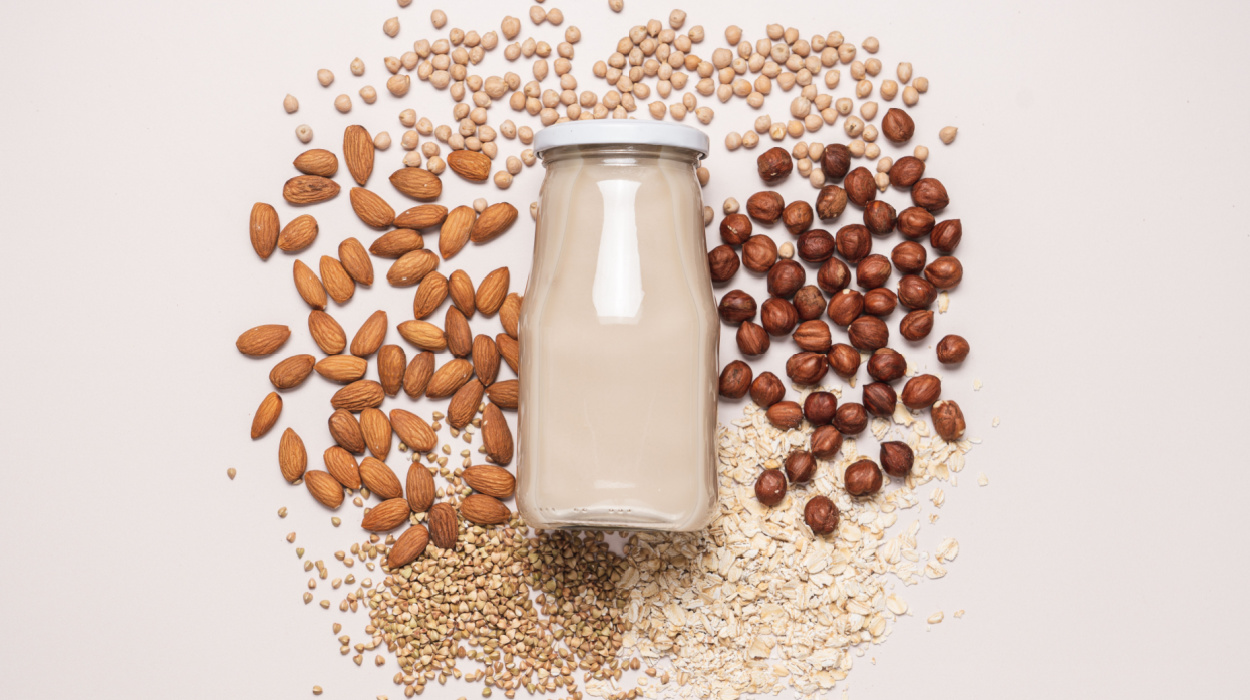Low FODMAP Diet: What It Is, Benefits & Sample Meal Plans 2024

Digestive system problems can greatly reduce the quality of life. Especially in recent years, the prevalence of irritable bowel syndrome, or IBS, has increased considerably due to stress and poor eating habits.
If you have IBS, you may have heard that there are various dietary approaches to manage it. The low-FODMAP diet is one novel dietary approach many are using. Let’s examine what kind of nutrition protocol is involved in this diet and who it may be good for.
The Low-Fodmap Diet For Beginners: A Sample Meal Plan
Sample Low-FODMAP Diet Plan
Breakfast: Berry Oat Bowl (Approx. 241 Calories)
This nutritious breakfast option combines fiber-rich oats with low-FODMAP berries and heart-healthy pumpkin seeds. It’s gentle on the digestive system, providing sustained energy and promoting regularity. Plus, the almond milk adds a creamy touch without high FODMAP ingredients, making it an ideal choice for those with sensitive stomachs.
| Breakfast | |
| Rolled oats | Half a cup |
| Almond milk | One cup |
| Mixed berries (e.g., strawberries, blueberries, raspberries) | Half a cup |
| Pumpkin seeds | One tablespoon |
Lunch: Chicken And Walnut Salad (Approx. 550 Calories)
Packed with lean protein from grilled chicken, this salad offers a satisfying and filling midday meal. The mix of salad greens, ripe tomatoes, and crunchy walnuts provides essential nutrients while keeping FODMAPs in check. Feta cheese adds a burst of flavor without causing digestive discomfort, making it a delicious and wholesome choice.
| Lunch | |
| Grilled chicken breast | Five ounces |
| Mixed salad greens | Two cups |
| Sliced tomato | One tomato |
| Walnuts | A quarter cup |
| Crumbled feta cheese | A quarter cup |
Snack: Refreshing Pineapple (Approx. 82 Calories)
A cup of fresh pineapple chunks serves as a delightful snack option. Pineapples are naturally low in FODMAPs and contain bromelain, an enzyme that aids digestion. This snack offers a sweet and tropical taste, making it a satisfying and digestion-friendly choice between meals.
| Snack | |
| Fresh pineapple chunks | One cup |
Dinner: Grilled Beef And Zucchini Delight (Approx. 210 Calories)
Lean beef steak and grilled zucchini make for a hearty and flavorful dinner. The beef provides a rich source of protein and essential nutrients, while zucchini adds a low FODMAP vegetable element. This dish is a savory and satisfying option for ensuring both flavor and digestibility
| Dinner | |
| Omelet with bell peppers and shredded sweet potatoes | Five ounces |
| Sliced and grilled zucchini | One medium-sized |
| Season with salt and pepper | Varies |
Snack: Kiwi And Walnut Boost (Approx. 119 Calories)
A sliced kiwi and a handful of walnuts create a balanced snack that’s rich in nutrients. Kiwis are a low FODMAP fruit known for their vitamin C content and digestive benefits. Combined with walnuts, which provide healthy fats and added texture, this snack is not only delicious but also supports overall well-being.
| Snack | |
| Sliced kiwi | One fruit |
| Walnuts | 10-12 walnut halves |
You can try many new recipes with a good variety of foods during your diet period. Even though it is a form of an elimination diet, it still has a large range of foods you can safely consume while you’re following the protocol.
What Is A Low-FODMAP Diet?
The acronym FODMAP is an abbreviation for fermentable oligosaccharides, disaccharides, monosaccharides, and polyols. These are short-chain carbohydrates[1] that your small intestine may have trouble absorbing if you have digestive problems such as irritable bowel syndrome or IBS.
If you experience the following symptoms after a meal, you may have a form of IBS or other digestive problems:
- Cramps
- Diarrhea
- Constipation
- Bloating
- Gas
The low FODMAP diet is a 3-step diet to manage symptoms of medically diagnosed IBS. Here is the guide for the low-fodmap diet for beginners.

Step 1: Low FODMAP Diet
This process covers the first two to six weeks. The aim is to provide symptom control and completely remove high-FODMAP foods from the diet. You can only consume allowed low-FODMAP certain foods.
Step 2: FODMAP – Reintroducing
In the second step, the low-FODMAP diet continues, but one new high-FODMAP food is reintroduced at a time. In this way, you can identify which FODMAP foods the individual is intolerant to and which ones they are not. The goal is to identify individual FODMAP sensitivities while maintaining the least restrictive diet possible. The complete cycle of this diet can take eight to twelve weeks.
Step 3: FODMAP – Personalization Diet
In this step, well-tolerated high FODMAP foods are included back into the diet, and intolerant high FODMAP foods are removed from the diet or restricted to asymptomatic levels.
The goal is to create a personalized diet with minimal restrictions over the long term.
Benefits Of A Low-FODMAP Diet
IBS[2] is a common digestive system problem that causes symptoms such as stomach cramps, bloating, diarrhea, and constipation. These symptoms tend to come and go over time and can last for days, weeks, or months.
IBS is often a lifelong problem and can have a huge impact on your daily life. There is no cure yet, but dietary changes and medications can help control symptoms.
A low FODMAP diet can also be applied in small intestine bacterial overgrowth[3] or SIBO conditions which leads to unwanted growth of bacteria in the intestine because carbohydrates can serve as primary nutrients for many bacteria and provide a nutrient-rich environment for bacterial growth. Still, studies on this subject are very limited, and further studies are needed.
Low-FODMAP Foods To Eat
Veggies

Some vegetables contain fermentable carbohydrates that can be hard to digest. However, there is no harm in consuming eggplant, green beans, Chinese cabbage, red pepper, carrot, cucumber, lettuce, potato, tomato, and zucchini vegetables.
Fruits
Fruits such as melon, grapes, kiwi, tangerines, oranges, pineapple, and strawberries are suitable for a low-FODMAP diet.
Dairy Products

Because milk contains lactose, it should be excluded from the diet, especially in the first step of the diet, as it can cause intestinal indigestion.
Instead, lactose-free milk can be consumed. In addition, almond milk and soy milk, which are herbal milk alternatives, may also be preferred.
It is okay to consume dairy products such as feta and hard cheeses on a low-FODMAP diet.
Protein Sources
Dietary protein sources that are safe to have include eggs, firm tofu, cooked meats/poultry/seafood, and tempeh.
Grains
Cereals are the group with the highest risk of containing fermentable carbohydrates, and care should be taken in their consumption. If you are on a low-FODMAP diet, it will be necessary to stay away from gluten-containing products for a while.
Oats, quinoa, rice, corn, and gluten-free bread are preferred.
Nuts
Peanuts pumpkin seeds, walnuts, and macadamia nuts are suitable for a low-FODMAP diet.
Sweets
You can suppress your sweet cravings on a low-FODMAP diet. The use of dark chocolate, maple syrup, rice malt syrup, and white sugar is suitable.
However, even though these products, especially white sugar, are okay on a low-FODMAP diet, keeping their intake at a minimum will be beneficial, as they are not suitable for general health.
Foods To Avoid On The Low-FODMAP Diet
For a low-FODMAP diet to be beneficial, it is necessary to know your own tolerance in terms of what you should or not restrict. It is possible to come across certain foods that you cannot tolerate in every food group, so knowledge of your tolerance is power.
Here is a general list of low-FODMAP foods you should limit on a low-FODMAP diet.
Veggies
Artichokes, asparagus, cauliflower, garlic, peas, mushrooms, and onions are among the vegetables you should not consume in this diet due to their high FODMAP content.
Fruits
Fruits such as apples, apple juice, cherries, dried fruits, mangoes, nectarines, peaches, pears, plums, and watermelon should not be consumed during the diet.
Dairy Products
As we mentioned above, cow’s milk is not suitable for a low-FODMAP diet due to its lactose content. In addition, heavy cream, evaporated milk, ice cream, soy milk, sweetened condensed milk, and yogurt are not recommended during the diet.
Protein Sources
Legumes, which are a source of vegetable protein, often lead to digestive problems and are not suitable for a low-FODMAP diet. Processed meats should also not be consumed.
Grains
Wheat, rye, barley-based bread and flour, breakfast cereals, biscuits, and snack products containing gluten are high in FODMAPs and should not be consumed during this diet.
Nuts
Cashews and pistachios should not be consumed during the low-FODMAP diet.
Sweets
High fructose corn syrup, glucose syrup, honey, and sweeteners should be avoided on a low-FODMAP diet.
This diet shows some similarities and differences with the lectin-free diet. The lectin-free diet aims to remove the protein called lectin from the diet, while this diet limits indigestible carbohydrate products.
Therefore, while both restrict pulses, gluten-containing foods, and foods containing lactose, the lectin-free diet also restricts grains such as quinoa and rice and vegetables such as potatoes, eggplant, tomatoes, and peppers.
Who Might Benefit From A Low-FODMAP Diet?
Low-FODMAP Diet For IBS
A systematic review[4] showed that a FODMAP-restricted diet improved IBS symptoms such as including abdominal pain, bloating, the passage of gas, nausea, heartburn, and lethargy in four studies, but it only improved constipation-dominant IBS in one study out of three.
However, in these three studies, fiber consumption was effective in constipation-dominant IBS patients. In the same review, fiber was found beneficial in five studies out of seven on chronic constipation. Findings suggest that fiber supplementation is beneficial in mild to moderate chronic constipation and constipation-dominant IBS.
Low-FODMAP Diet For SIBO
There is a close relationship between IBS and SIBO which is an unwanted overgrowth of bacteria in the intestine. High FODMAP foods may provide a nutrient-rich environment for bacterial growth. For this reason, it is often thought that a low-FODMAP diet that works for IBS can also be applied to SIBO.
However, a very recent comprehensive review[5] published in Nutrients journal in 2022 indicates that a low-FODMAP diet can promote an adverse change in the gut microbiota and deepen the existing microbiota disruption in SIBO patients.
This study also indicates that soluble fiber supplementation may be effective in reducing symptoms of IBS and SIBO, and targeted probiotic therapy may be beneficial.
It was also stated that the effectiveness of antibiotic therapy,[6] which is the main treatment of SIBO, can be increased with soluble fiber supplementation and that it can regulate bowel movements. More research is needed to establish a specific diet for the treatment of SIBO.
Probiotic/Prebiotic Aspect
Prebiotic foods contain dietary indigestible substances such as polysaccharides, which are nutrients for microbiota and improving health and are also included in high-FODMAP foods. The International Scientific Association for Probiotics and Prebiotics defined specific food and nutrient groups as prebiotics,[7] a substrate that is selectively utilized by host microorganisms conferring a health benefit.
On the other hand, there are foods called probiotics that directly contain healthy bacteria for the gut. Prebiotics and probiotics are foods that have been researched and found beneficial[8] for digestive and many other health problems for years but are controversial because they are not suitable for a low-FODMAP diet system.
A narrative review[9] examined the systematic reviews and meta-analyses published from 2013 to 2018 on prebiotics, probiotics, and low FODMAP diet effects on IBS to compare the effects of these three as a treatment method.
Results stated that 11 systematic reviews and meta-analyses accepted probiotic, but not prebiotic, therapy as safe and effective in improving and managing IBS symptoms.
They also mentioned that short-term restriction of FODMAP leads to symptomatic improvements in IBS. According to this comprehensive review, a low-FODMAP diet has been found to be beneficial for IBS patients.
Inappropriate Use Of The Low-FODMAP Diet
This refers to the use of a low-FODMAP diet in healthy people or people who do not need it. Studies in healthy individuals show that consumption of indigestible carbohydrates provides an increase[8] in beneficial bacteria such as Bifidobacteriaceae and Lactobacillaceae.
These bacteria can either ferment prebiotic components or metabolize the prebiotic, releasing nutrients for other bacteria to use and promoting the growth of other species. They improve health through a variety of mechanisms, including the production of short-chain fatty acids.
The diet contradicts the concept of prebiotics and related findings. Additionally, it may lead to negative effects[10] such as reduced health-related bacteria such as Bifidobacteria, and adversely affects the gut microbiota in patients with intestinal disorders.
Therefore, further studies are needed for the effects of this diet on long-term gut health both for those with and without digestive conditions.
Final Thought
A low-FODMAP diet is a nutritional approach that can reduce symptoms for celiac disease and IBS patients with diarrhea, abdominal pain, and bloating. However, the long-term application of this diet especially for the general population is not recommended, and its effects on intestinal symptoms are not clearly known.
It is a fact that many foods that are restricted in the low-FODMAP diet have health benefits. The fermentation of indigestible carbohydrates (i.e. high-FODMAP foods) supports a balance of healthy bacteria in the microbiota. For this reason, it is beneficial to follow the low-FODMAP protocol only with the approval and control of authorized clinicians and dietitians.
+ 10 sources
Health Canal avoids using tertiary references. We have strict sourcing guidelines and rely on peer-reviewed studies, academic researches from medical associations and institutions. To ensure the accuracy of articles in Health Canal, you can read more about the editorial process here
- Su, H., Li, Y.-T., Heitkemper, M.M. and Zia, J. (2019). Effects of Low-FODMAPS Diet on Irritable Bowel Syndrome Symptoms and Gut Microbiome. Gastroenterology Nursing, [online] 42(2), pp.150–158. doi:10.1097/sga.0000000000000428.
- NHS Choices (2022). What is IBS? – Irritable bowel syndrome (IBS). [online] Available at: https://www.nhs.uk/conditions/irritable-bowel-syndrome-ibs/.
- Abimbola Adike and DiBaise, J.K. (2018). Small Intestinal Bacterial Overgrowth. Gastroenterology Clinics of North America, [online] 47(1), pp.193–208. doi:https://doi.org/10.1016/j.gtc.2017.09.008.
- Satish S.C. Rao, Yu, S. and Fedewa, A. (2015). Systematic review: dietary fibre and FODMAP‐restricted diet in the management of constipation and irritable bowel syndrome. Alimentary Pharmacology & Therapeutics, [online] 41(12), pp.1256–1270. doi:https://doi.org/10.1111/apt.13167.
- Justyna Paulina Wielgosz-Grochowska, Domanski, N. and Małgorzata Ewa Drywień (2022). Efficacy of an Irritable Bowel Syndrome Diet in the Treatment of Small Intestinal Bacterial Overgrowth: A Narrative Review. Nutrients, [online] 14(16), pp.3382–3382. doi:https://doi.org/10.3390/nu14163382.
- Satish S.C. Rao and Jigar Bhagatwala (2019). Small Intestinal Bacterial Overgrowth: Clinical Features and Therapeutic Management. Clinical and Translational Gastroenterology, [online] 10(10), pp.e00078–e00078. doi:https://doi.org/10.14309/ctg.0000000000000078.
- Dorna Davani-Davari, Manica Negahdaripour, Iman Karimzadeh, Mostafa Seifan, Milad Mohkam, Seyed Jalil Masoumi and Aydin Berenjian (2019). Prebiotics: Definition, Types, Sources, Mechanisms, and Clinical Applications. Foods, [online] 8(3), pp.92–92. doi:https://doi.org/10.3390/foods8030092.
- Mary Ellen Sanders, Merenstein, D., Reid, G., Gibson, G.R. and Rastall, R.A. (2019). Probiotics and prebiotics in intestinal health and disease: from biology to the clinic. Nature Reviews Gastroenterology & Hepatology, [online] 16(10), pp.605–616. doi:https://doi.org/10.1038/s41575-019-0173-3.
- Soo Liang Ooi, Correa, D. and Sok Cheon Pak (2019). Probiotics, prebiotics, and low FODMAP diet for irritable bowel syndrome – What is the current evidence? Complementary Therapies in Medicine, [online] 43, pp.73–80. doi:https://doi.org/10.1016/j.ctim.2019.01.010.
- Vandeputte, D. and Joossens, M. (2020). Effects of Low and High FODMAP Diets on Human Gastrointestinal Microbiota Composition in Adults with Intestinal Diseases: A Systematic Review. Microorganisms, [online] 8(11), pp.1638–1638. doi:https://doi.org/10.3390/microorganisms8111638.



